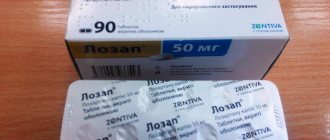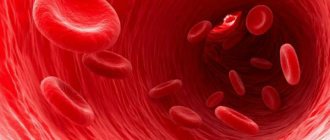This information explains how to prepare and give a subcutaneous injection (shot) of a blood thinner using a prefilled syringe. Throughout this material, we use the words “you,” “your,” and “yourself” to refer to you or your child.
You need to give yourself injections (shots) of medication to thin your blood. You will receive syringes already filled with medication from your pharmacy. You will inject the medicine into the fat layer under the skin using a small, thin needle.
You may receive a pre-filled syringe with a needle already attached to it, or you may need to thread it yourself. If you received a syringe without a needle, attach it by following the instructions in the “Preparing the Injection” section.
You will practice preparing and giving yourself an injection with your nurse. Refer to this material at home the first few times you inject yourself.
to come back to the beginning
Description of the medicine
The main effect of Heparin injections is to prevent pathological blood clotting by directly affecting the enzyme antithrombin III. Once the product enters the body, platelet synthesis is significantly reduced, which allows maintaining normal blood condition. The anticoagulant is widely used in medical practice both as a prophylactic drug and for the full treatment of many diseases.
Indications for use:
- vascular complications after surgery;
- reduction of blood viscosity in devices intended for artificial blood supply;
- getting rid of blood clots formed during heart surgery;
- treatment of diseases that provoke a decrease in blood microcirculation throughout the body;
- as a prophylactic agent among patients prone to blood clots;
- therapy for myocardial infarction;
- treatment of deep vein thrombosis;
- increased D-dimer levels during pregnancy;
- atrial fibrillation and some other pathologies.
Heparin is used as a stand-alone drug or in combination with medications of other groups, for example, Fibrinolysin, Streptodecase and others.
The dosage is selected by the leading physician on an individual basis. The specialist takes into account test results, medical history, features of the course of the disease and some other characteristics of the patient.
Safety of hormonal injections during IVF
If all actions are performed correctly, the risk of injury is minimal - you will feel a slight short-term pain as the needle enters. There may be slight bleeding at the injection site, which stops immediately. It is important to perform the injection quickly and carefully, without worry, since any delay will damage the tissue more, which will lead to the formation of a subcutaneous or intramuscular hematoma (bruise). It does not pose a danger to health or life, but the injection site will hurt more, and the drug will be less well absorbed by the tissues.
Take the first step
make an appointment with a doctor!
Before giving an injection in the stomach or buttock during IVF, be sure to consult with your doctor - he will tell you in detail and show you how to perform the procedure. Be sure to follow the dose of medications recommended by your specialist and perform injections regularly at the same time of day. Otherwise, a hormonal overdose is possible, which can provoke hyperstimulation syndrome and other negative side effects.
Who is indicated for Heparin injections into the abdomen?
Heparin is classified as a direct anticoagulant. This substance is included in various medications, including ointments, tablets, and injections. Heparin is administered into the abdomen by injection; indications for use include:
- acute coronary syndrome due to myocardial infarction;
- thromboembolism affecting the vessels of the eyes, respiratory system and brain;
- atrial fibrillation causing embolism;
- for the prevention of pulmonary embolism in the period after surgery;
- blood transfusion from donor to patient;
- unstable forms of angina;
- heart defects;
- rheumatism;
- jades;
- asthma.
Heparin is used to reduce blood viscosity
Heparin injections reduce the negative manifestations of the described diseases, and in some cases, such treatment allows you to completely get rid of the pathology.
Action of injections
To understand why Heparin is injected, let’s find out what the main pharmacological features of this substance are. In a healthy person, heparin, together with fibrinolysin, is part of the body's natural anticoagulant system. The substance prevents the formation of platelets, reduces their adhesion, and catalyzes the process of dissolving blood clots. Thanks to this, renal and coronary blood flow significantly improves, which makes it possible to use the medicine for many cardiovascular diseases.
Important! Use of the drug among patients with reduced blood clotting may lead to bleeding and other dangerous consequences.
How long does it take to work?
After entering the body, the effect of Heparin begins quite quickly, but the effect is relatively short-lived. When administered intravenously, the effect occurs almost immediately and is observed for 4–5 hours. After intramuscular injection, the effect occurs within half an hour, its duration is 6 hours. If Heparin is used subcutaneously, inhibition of blood clotting is observed after 60 minutes and lasts from 6 to 12 hours.
The first option is used primarily for the treatment of life-threatening conditions in humans, such as thrombosis, embolism, myocardial infarction and other severe pathologies. Subcutaneous and intramuscular injections are used in medical practice for long courses aimed at the prevention and treatment of diseases characterized by increased blood viscosity.
What to do if something touches the needle
If you are using a syringe with a pre-attached needle, dispose of it in a sharps container. Start the procedure again with a new pre-filled syringe.
- If you throw away a syringe with a pre-attached needle, you will need to get a new dose of the medicine. Call your doctor for a prescription.
- If you put the needle on the syringe yourself, follow the steps below to replace the needle.
- Remove the old needle from the syringe by turning the base of the needle counterclockwise (to the left, Figure 4).
- If you are unable to turn the needle, carefully recap it. Then try turning it again.
- After you remove the needle, throw it into a sharps container. Make sure nothing touches the base of the syringe.
- Remove the new capped needle from the package. Place the needle on the syringe by turning it clockwise (to the right).
Figure 4. How to rotate the needle at the base
to come back to the beginning
Contraindications
The administration of Heparin injections into the abdomen is strictly contraindicated in some situations. Direct contraindications include:
- allergy to the main active ingredient of the drug;
- a blood disorder characterized by a low platelet count;
- severe pancreatic dysfunction;
- internal or external bleeding;
- arterial hypertension;
- serious pathologies of the liver and kidneys;
- alcoholism;
- threat of miscarriage.
During therapy, it is necessary to take into account the contraindications of the drug
It is forbidden to inject the drug in case of leukemia, anemia, aortic aneurysm, subacute endocarditis of bacterial origin, gastric and intestinal ulcers, after spinal cord puncture.
VTE - venous thromboembolism
INR - international normalized ratio
LMWH - low molecular weight heparin
TEO - thromboembolic complications
AF - atrial fibrillation
In the United States, more than 2.5 million patients are chronically treated with anticoagulants due to the development of venous thromboembolism (VTE), implantation of mechanical valve prostheses in the heart, or atrial fibrillation (AF) [1]. Every year, in approximately 10% of such patients, the use of anticoagulant therapy is temporarily stopped due to invasive interventions. To select an acceptable management strategy for such patients, it is necessary to assess the risk of thromboembolism and severe bleeding during the intervention period. A temporary change in anticoagulant therapy during the intervention period is usually referred to in the English literature as “bridging therapy.” This change in therapy usually involves the use of parenteral short-acting anticoagulants while warfarin is temporarily discontinued. Below is a systematic approach to choosing tactics for using anticoagulant therapy during invasive interventions.
There is no generally accepted tactics for the use of anticoagulant therapy during the period of invasive intervention in patients taking warfarin for a long time. However, a systematic approach to choosing such tactics may be useful. If it is necessary to perform an urgent or emergency intervention, there is usually no time to transfer the patient to therapy with another anticoagulant for the duration of the intervention. The effect of warfarin in such cases can be reversed by administration of fresh frozen plasma and parenteral administration of vitamin K.
If the proposed intervention is considered planned, it is necessary to answer the question about the need to stop taking the anticoagulant during its implementation. It should be noted that many interventions can be performed safely without interruption of anticoagulant use. These include, for example, tooth extraction, bone marrow biopsy, endoscopy (including mucosal biopsy), cataract surgery, pacemaker installation, venography, dermatological operations, and aspiration of fluid from the joint cavity. Before performing such interventions, the intensity of warfarin therapy is usually reduced to achieve a lower therapeutic range of international normalized ratio (INR) values.
If anticoagulants must be discontinued, the need for a temporary switch to parenteral anticoagulant administration during the intervention should be assessed. Such a transition is not required in the following patients: 1) with a low risk of developing thromboembolic complications (TEC), including patients with AF and a CHADS2 score of 2 points or less in the absence of previous thromboembolism and blood clots in the cavities of the heart; 2) in the presence of a bicuspid mechanical prosthesis implanted in the aortic position in the case of maintaining sinus rhythm and in the absence of previously suffered thromboembolism; 3) who had VTE more than 3 months ago in the absence of active forms of cancer. In such patients, warfarin can be discontinued 4-5 days before the intended intervention. On the morning of the intervention, confirmation should be obtained that the INR level is within the required range. Warfarin administration in such cases is resumed on the day of the intervention, as soon as hemostasis is achieved and the patient can take the drug. Postoperative patient characteristics that should be considered when deciding whether to restart warfarin include the need for additional intervention and the expected timing of its implementation; the use of drugs that interact with warfarin, including antibiotics; limited food intake. The need for more frequent INR determinations should be taken into account. In addition, appropriate mechanical and pharmacological methods for VTE prophylaxis should be used until anticoagulant therapy has been fully resumed.
The ongoing Bridge Trial, funded by the National Institutes of Health, will evaluate the safety and effectiveness of temporarily switching patients with AF to low molecular weight heparin (LMWH) during invasive procedures [2]. This study is expected to enroll 3626 patients and will end in 2014 or 2015. It is believed that the results of this study will answer the question of whether temporary switching to LMWH is required during the period of invasive surgery in patients with AF and AF. CHADS2 score 3 or 4, with no history of stroke or thromboembolism.
In cases where the risk of thromboembolism is assessed as moderate or high, a temporary transfer of the patient to parenteral LMWH is considered mandatory. According to experts, in patients observed on an outpatient basis, in such cases, subcutaneous administration of LMWH is preferable whenever possible due to the convenience of dosing, safety and low cost of such therapy [3, 4]. In case of severe renal impairment (decrease in creatinine clearance to 15-30 ml/min, which corresponds to stage IV of chronic kidney disease), the dose of LMWH should be reduced; in addition, monitoring of anti-Xa activity is necessary during therapy [5]. In patients with stage V chronic kidney disease, intravenous infusions of unfractionated heparin should be used for such purposes. After discontinuation of warfarin, the daily dose of LMWH is started as soon as the INR falls below the therapeutic range [6–8]. In patients at high risk of developing TEC who have mechanical valve prostheses implanted, LMWH is administered 2 times a day in accordance with clinical recommendations [9, 10]. In all other cases, LMWH is administered once. In order to avoid the residual effect of LMWH on the day of surgery, in the morning of the day of surgery, but before the start of its implementation, LMWH is administered at a dose corresponding to 50% of the calculated daily dose [11]. After surgery, warfarin should be restarted with caution at the earliest opportunity. Heparin can be administered no earlier than 48 hours after completion of the operation in order to reduce the risk of severe bleeding, and the possibility of using small doses of heparin should be considered [6-8, 12]. After surgery where there is a high risk of severe bleeding, when heparin is reintroduced, its use should initially be limited to prophylactic doses, if it can be used at all. Intravenous administration of unfractionated heparin without bolus administration has the advantages of rapid elimination of the drug and the possibility of neutralizing its effect due to the administration of protamine; in such cases, this approach to heparin therapy may be preferable. In patients with VTE after surgery, prophylactic use of LMWH is acceptable. Moreover, warfarin and heparin should be used simultaneously for at least 5 days or until the INR corresponds to the therapeutic range, depending. Depending on the indications and the nature of the invasive procedure, aspirin may be discontinued 1 week before the intended intervention.
In patients with a history of VTE, there is a general tendency to implant a filter into the inferior vena cava as a component of VTE prophylaxis during an invasive procedure [8]. In patients with acute or subacute VTE, elective surgery should be postponed until the period of anticoagulant use has reached 3 months. Implantation of a filter into the inferior vena cava can only be recommended for patients who require urgent surgical intervention within a month after the diagnosis of VTE. It is preferable to implant removable filters, which should be removed as soon as the need for their use ceases.
If there is a history of thrombocytopenia due to the use of heparin, the administration of any heparin preparations should be avoided. Short-acting direct thrombin inhibitors such as argatroban, lepirudin or bivalirudin are used as alternative therapy in such cases. The use of desirudin is particularly attractive because it can be administered subcutaneously, allowing the patient to be monitored on an outpatient basis. In patients with thrombocytopenia caused by the use of heparin, fondaparinux is often used, but its use during invasive interventions is problematic due to the long half-life, which reaches 17-21 hours.
In general, the risk of bleeding during interventions is 2 times higher than the risk of thrombosis. Relatively recently, the BleedMAP scale was developed to assess the risk of bleeding during an invasive procedure [12]. When assessed using this scale, a score of 1 corresponds to each of the following risk factors: a history of bleeding (Bleed), a mechanical valve implanted in the heart (M), active cancer (A), and a low blood platelet count (P, for platelet; platelet count 150,000/µl or less). Although the validity of such a scale has not yet been assessed in a prospective study, its use allows the risk of bleeding to be established based on clinical data. It should also be noted that this is currently the only scale available to assess the risk of bleeding when using anticoagulants during an invasive procedure.
The tactics of anticoagulant therapy in patients taking “new” anticoagulants are separately considered. Dabigatran etexilate (Pradaxa) is an oral direct thrombin inhibitor that has been approved by the US Food and Drug Administration for use in the prevention of stroke in patients with nonvalvular AF [13]. The period to achieve the maximum effect after taking dabigatran is about 1 hour, the half-life of the drug reaches approximately 15 hours, and it is eliminated predominantly (about 80%) through the kidneys. Rivaroxaban (Xarelto) is an oral direct factor Xa inhibitor that has also been approved by the US Food and Drug Administration for use in the prevention of stroke in patients with non-valvular AF [14], as well as for the prevention of VTE after prosthetic replacement. large joints. Rivaroxaban is metabolized in the liver (33%) and excreted through the kidneys (66%). The half-life ranges from 7 to 11 hours.
According to experts, the management of patients taking dabigatran or rivaroxaban is more conservative than the recommendations of the manufacturers of these anticoagulants, which is due to several reasons [15]. Firstly, the incidence of thromboembolism during invasive interventions is low (1%). Secondly, after taking both dabigatran and rivaroxaban, their onset of action is rapid (within 1-2 hours), and the half-life of both drugs is quite long. Third, there is no antidote for dabigatran. Data have been obtained that the use of prothrombin complex concentrate leads to neutralization of the effect of rivaroxaban in healthy volunteers [16].
The first step is to evaluate the risk of bleeding associated with a particular type of surgery and a particular type of anesthesia (eg, spinal). In any case, the operating surgeon and anesthesiologist must be aware that the patient is taking a “new” anticoagulant. It is also necessary to re-determine creatinine clearance to ensure that the dose used is correct. If the intervention is urgent or urgent, an increased risk of bleeding should be expected and this risk should be weighed against the possible consequences of delaying the intervention. Mechanical interventions to stop bleeding include suturing the vessel, clipping it, applying pressure to the bleeding area, cooling, cauterization, and topical thrombin. In case of massive bleeding, the decision to use hemostatic agents such as prothrombin complex concentrate, Factor Eight Inhibitor Bypass Activity complex or recombinant factor VIIa should be made taking into account the risk of thrombotic complications [15, 16].
During planned interventions in patients taking “new” anticoagulants, creatinine clearance should first be assessed. In patients with a creatinine clearance of 50 ml/min or more before intervention, it is recommended to discontinue the anticoagulant for a period corresponding to 4-5 half-lives of the drug. In patients with creatinine clearance less than 50 ml/min, the duration of the period of discontinuation of the drug should be increased by another 2 days. Before surgery with a high risk of bleeding, a normal activated partial thromboplastin time or thrombin time indicates sufficient elimination of dabigatran. There are currently no laboratory tests available to confirm complete elimination of rivaroxaban. In most cases, transferring a patient to heparin during an invasive procedure is usually not indicated. After surgery, it is necessary to re-ensure sufficient kidney function. Resumption of dabigatran and roveroxaban should be delayed for 48 hours, and their use is possible only if complete control of bleeding is confirmed. It should be noted that within 1-2 hours after resuming dabigatran and rivaroxaban, the patient will achieve full anticoagulant effect. If the patient has a high risk of bleeding or additional interventions are expected to be performed in the near future, according to experts, it is advisable to use standard anticoagulant therapy, the effect of which can be eliminated if necessary.
Currently, researchers have provided data on 4591 patients with non-valvular AF who, during the study, were randomly assigned to the dabigatran group (110 or 150 mg 2 times a day) or the warfarin group [17]. Dabigatran and warfarin were discontinued on average 2 and 4 days before the intervention, respectively. The time of resumption of anticoagulants after the intervention was determined by the attending physician. The incidence of bleeding within 30 days was not statistically significantly different between groups (in the dabigatran 110 mg twice daily group, in the dabigatran 150 mg twice daily group, and in the warfarin group, the incidence reached 3.8, 5.1 and 46% respectively), but overall was 2 times higher than previously reported for warfarin therapy. The incidence of TEC was low, approximately 1% in each group. Despite the importance of such data, the disadvantages of this article should be noted: the secondary nature of the analysis, changes in treatment tactics during the study, the lack of a standardized approach to anticoagulant therapy (especially when deciding on its resumption after the intervention) and the lack of a standard definition of “major” intervention. In fact, less than 17% of the interventions performed in the study could be classified as “major” from the perspective of practitioners. According to experts, until additional data is obtained on the incidence of bleeding in patients who have undergone “major” interventions, the approach to determining the tactics of using anticoagulants during the period of interventions should remain conservative.
Moreover, in their practice, experts avoid the use of dabigatran and rivaroxaban in cases of catheter installation in the spinal cord canal and/or epidurally or in the deep plexus due to the increased risk of hematoma development. After removal of catheters installed in the spinal cord canal or deep plexus and/or in the peripheral parts of the nervous system, resumption of dabigatran and rivaroxaban should be delayed for 24 hours.
It should also be noted that patients with active forms of cancer who take anticoagulants for a long time have a predisposition to the development of both thrombosis and bleeding. Anticoagulant therapy in such cases is complicated by the use of chemotherapy, the installation of central venous catheters, the presence of cytopenias, the use of hormonal agents, drug interactions, as well as variability in diet and diet. The results of a recent study [18] indicate that during the period of invasive procedures in a subgroup of patients with active forms of cancer (n = 493) compared with a subgroup of patients who did not have cancer (n = 1589), the incidence of VTE and severe bleeding was statistically significantly higher: VTE developed in 1.2 and 0.2% of patients, respectively, and severe bleeding - in 3.4 and 1.7% of patients, respectively. This difference was mainly driven by data from patients who used anticoagulants for cancer-related VTE. In such patients, during the period of invasive interventions, experts recommend a more frequent transfer to LMWH therapy in sufficient doses. The last dose of LMWH administered 24 hours before the intervention should be 50% of the total daily dose of the drug. After intervention, the use of LMWH should be limited to prophylactic doses until complete control of bleeding is confirmed. The use of therapeutic doses of LMWH should be avoided for 48 hours after the procedure to prevent severe bleeding. Many patients with cancer-related VTE are treated with long-term LMWH.
Features of the procedure
How to give injections yourself? The technique for administering Heparin into the abdomen by injection is quite simple. To do this, the patient must perform the following actions:
- Wash your hands thoroughly with soap and wear sterile gloves.
- Prepare an ampoule with medicine, a syringe, cotton wool, and a disinfectant.
- Open the ampoule and draw the drug into the syringe.
- Wipe the skin with cotton wool or a bandage soaked in an alcohol solution or any other disinfectant.
- At a distance of 4 cm from the navel, pinch a fold of skin and insert a needle into it. The injection should be given slowly, listening to your feelings.
- After administering the medicine, you need to pull out the needle and apply a cotton swab with a disinfectant solution to the injection site.
The injection should be given in strict accordance with the instructions
Important! If the patient is giving an injection for the first time, it is advisable to do it under the supervision of a medical professional.
Storing medical needles
- Use an empty plastic container with a screw cap, such as a detergent bottle. Choose a container that is thick enough that the needles will not pierce the sides.
- Choose a container that is unbreakable.
- Do not store medical needles in glass bottles, plastic drink bottles, milk bottles, aluminum cans, coffee cans, paper or plastic bags.
to come back to the beginning
Use during pregnancy
Many women are diagnosed with pathological changes in blood composition during pregnancy. According to clinical studies, it turned out that despite the fact that the medicine may cause some side effects, the benefits of its use are still higher than the expected risks.
It should be noted that during pregnancy the instructions for use of the drug and the recommendations of the attending physician must be strictly followed. If the usual dose of medication for an adult patient is 5 thousand units. per day, for a pregnant woman the daily norm is determined depending on the patient’s weight and other characteristics of the body.
During therapy, it is advisable to use calcium supplements, since Heparin disrupts the distribution of this substance in the body.
The medicine is not able to penetrate the placenta, so pregnant women should not fear for the health of the fetus.
What injections are prescribed for IVF?
When preparing and conducting in vitro fertilization, the patient is prescribed the following types of hormonal injections:
- HCG injections before IVF . HCG (human chorionic gonadotropin) is a hormone that is produced by the tissues of the placenta and plays a decisive role in the successful course of pregnancy. In addition, it has a pronounced follicle-stimulating effect - that is, it promotes the rapid maturation of follicles containing eggs. Subcutaneous injections of hCG-based drugs can increase the number of mature oocytes produced by the female body during 1 menstrual cycle - accordingly, increasing the chances of successful artificial insemination.
- Injections of progesterone and estradiol . These hormones are necessary to prepare the endometrium (the mucous layer of the uterus) for implantation of the embryo, the successful fixation of the embryo and its further intrauterine development, and the formation of the placenta. Most often, doctors use gels and suppositories containing progesterone and estradiol, but they can also prescribe intramuscular injections of an oil solution of the pure substance.
In addition to these main groups of substances, during IVF injections of other hormones, anticoagulants that prevent vein thrombosis, etc. may be prescribed. The list of drugs depends on which IVF protocol is prescribed to the patient. For example, in the long one, drugs are alternately used to stimulate and inhibit ovulation in order to synchronize processes in the female body and thereby increase the chances of successful conception. In a short and natural IVF protocol, minimal or no hormone injections may be used to avoid causing ovarian hyperstimulation syndrome.
Side effects
Like many other medications, Heparin sometimes leads to side effects. These include the following conditions:
- changes in taste and loss of appetite;
- diarrhea;
- allergic manifestations in the form of urticaria, itching, irritability of the dermis;
- bronchospasms are rarely diagnosed;
- hematomas and bleeding at injection sites;
- pathological decrease in platelet concentration in the blood.
With long-term treatment with the drug in question, cases of the development of osteoporosis and spontaneous fractures against its background have been recorded.
To prevent the conditions described above, you should refrain from self-medication and use the medicine only as prescribed by a specialist. This will help achieve an optimal therapeutic effect and avoid complications.
Preparing for injections during IVF
Injections within the framework of in vitro fertilization are carried out subcutaneously or intramuscularly. Both methods simplify the procedure and make it safer, since there is no need to insert the needle directly into the vein. However, such injections also require preparation and certain knowledge.
Subcutaneous injections are made to certain places on the body where there is a sufficient layer of fatty tissue:
- the triceps (extensor muscle) area on the side and back of the arm, located between the elbow and shoulder;
- the lateral side of the thigh, closer to its outer part (in the area of the quadriceps muscle);
- the thick part of the abdominal area located below the ribs but above the hips and not directly next to the umbilical cord.
For each injection, new needle entry points must be selected (within the specified areas). If injections are made into the same place, then due to tissue trauma, an inflammatory focus will appear in it, which can either become infected or become very dense due to scarring.
Before giving injections for IVF, you need to buy medications prescribed by your doctor. Today they come in convenient disposable syringe capsules or reusable syringes with replaceable needles. In addition, for safe injections you need:
- container for safe disposal of needles and used doses of the drug;
- alcohol or other disinfecting liquid (gel, injection wipes);
- sterile gauze pad (usually 2 x 2 cm);
- clean towel (napkin).
Take the first step
make an appointment with a doctor!
If the fertility specialist prescribed injections of only half the bottle, the remaining part of the drug should be stored in the refrigerator in a tightly closed container.











